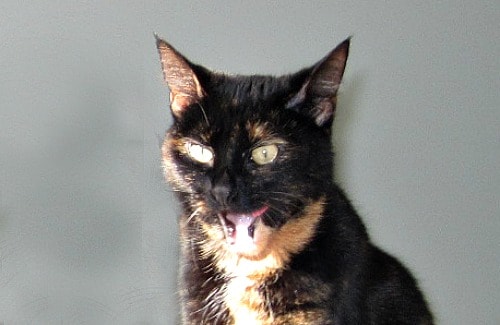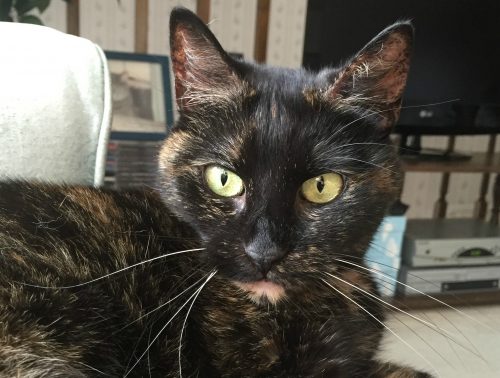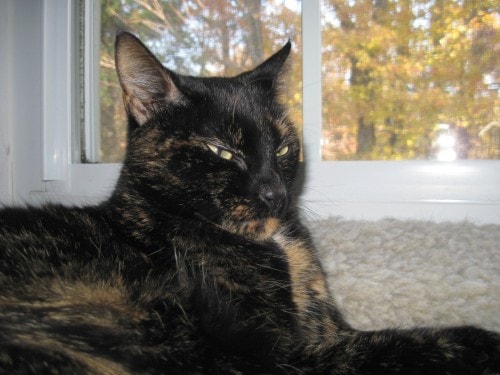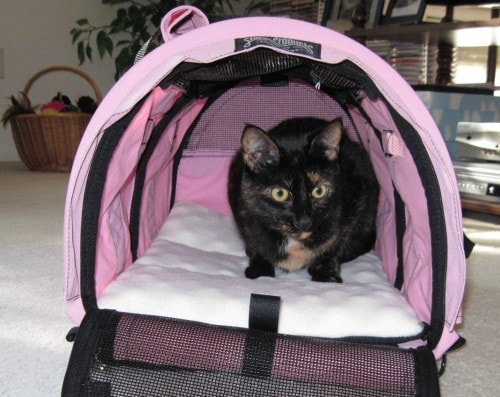Finding out that your cat needs dental work provokes anxiety in most cat guardians, and despite my years of working in veterinary clinics, and having been through many dental procedures with the cats that came before Allegra and Ruby, there’s not much that makes me feel as anxious as the thought of one of my babies having to undergo anesthesia. This is a four-part series in which I share my recent experience with Allegra. I’m hoping that it will not only put your minds at ease if you’re faced with a cat who has to have a dental procedure, but that it will also help you ensure that your cat gets the optimal level of care before, during and after her dental work.
The importance of dental health
Dental disease is the most frequently diagnosed health problem for cats. According to the American Veterinary Dental Society, an astounding 70 percent of cats show signs of oral disease by age 3.
Normal teeth should be white or just a little yellow. Gums should be light pink and smooth (except in breeds with pigmented gums). Oral disease begins with a build up of plaque and tartar in your cat’s mouth. Without proper preventive and therapeutic care, plaque and tartar buildup leads to periodontal disease, which manifests in red and/or swollen and tender gums, bad breath, and bleeding. When the gums are swollen, they can be painful – a good rule of thumb is that if it looks like it might be painful, it probably is. Cats are masters at masking pain – when in doubt, assume that your cat is experiencing at least some discomfort.
The inflammation and infection associated with periodontal disease can lead to damage to other organs such as the heart, kidney and liver, and lead to other serious health problems. Dental disease can also be an indicator of immune system disorders.
Allegra’s diagnosis
Allegra and Ruby get bi-annual exams by our wonderful holistic housecall vet, Andrea Tasi, VMD of Just Cats Naturally. At six and five years old, their teeth and gums have been in remarkably good shape on visual exam. These are the first cats for whom I’ve practiced daily brushing, and it is reassuring to me that it has been making such a big difference. All my other cats have needed annual or at least every other year dental cleanings.
During Allegra’s last exam the end of August, Dr. Tasi found evidence of a resorptive lesion, also referred to as feline odontoclastic resorptive lesions (FORLs), or Tooth Resorptive Disease of Felines (TRDF.) Tooth resorption is common; estimates are the condition affects between about 30 to 40 percent of healthy adult cats, and is diagnosed in 60 to 80 percent of cats who visit the vet for treatment of dental disease.
Tooth resorption is a progressive disease which begins with erosion of the surface layer of the root and then moves into the center of the tooth and the pulp. The resorption process continues until the enamel is completely resorbed, which can cause the tooth to fracture and/or remodel into a lump on the gum line.
As you can probably guess from this brief description, this is a painful condition. Since cats rarely show signs of pain unless the lesion is touched directly, this condition can only be diagnosed by a veterinary exam. Allegra had been reacting with some sensitivity in that area during brushing for a few weeks preceding the exam.
Choosing a veterinary dentist for Allegra
A couple of weeks ago, I published a list of 13 question to ask when selecting a veterinary dentist. A visual oral exam is usually not enough to properly diagnose dental disease. “When I recommend what I think might simply be a routine dental prophylaxis (cleaning and polishing), I warn my clients that there might be much more going on inside a cat’s mouth than meets the eye on even a careful and thorough physical exam, and that extractions are often needed,” says Dr. Tasi. Many general practices perform dentistries, but unless a practice is equipped to take and properly interpret dental radiographs, and unless a veterinarian is very experienced with complex dental procedures, a veterinarian who is board certified in veterinary dentistry is a better choice.
For me, the choice was easy: I took Allegra to Dr. Chamberlain at Animal Dentistry and Oral Surgery in Leesburg, VA. It’s where Dr. Tasi takes her own cats, and if she trusts Dr. Chamberlain with her own cats, that’s good enough for me. “I know that the services provided will be the highest standard of care”, says Dr. Tasi, “and that any challenge my patients’ mouths present will be handled with the expertise of a board certified specialist in dentistry.”






Is there some cat food that contains the enzymes that remove the tartar from cats’ teeth? I’m not sure my cats would adjust to teeth brushing. If I put the enzymes in the water, they may smell something about the water and refuse to drink it. I love your cat information. Thank you!
Eenzymes don’t remove tartar, Nadine. Water additive may help, but they’re not a substitute for brushing. I encourage you to try brushing. With patience, most cats will adjust. Here’s how to do it: https://ingridking.com/2011/11/07/brushing-your-cats-teeth/
So sorry you both have to go through this. When Zoe was 5 she needed to have several teeth removed. The worst part was having to leave her overnight. I tried to brush her teeth after that, but she never could tolerate it. Fortunately no dental problems since and she is 16 now! 😀
I’m glad Zoe is doing so well, Debi!
Once again you have made a daunting topic super accessible, Ingrid; thanks so much for covering this important health issue, and breaking down the barriers for other carers giving their furry ones the best possible care.
Thank you, Liz!
I think this will be an invaluable experience, Ingrid to all cat people, and so many of us will have gone through it with our cats. Do feel for Allegra of course; as you say, they are so clever at masking pain – she’s lucky to have you as her Mum who is on the lookout for ANY deviation from normal behaviour and both she and Ruby receive the very best care and attention from you.
One of our cats began dental problems when she was only three and by the time she went on to better things I think she had very few teeth left; none of it ever bothered her and she just plodded on with her life.
We have another who is now 15 nd had aq couple of dental procedures, it really doesn’t appear to bother them at all – thankfully.
As one of your readers has commented, worst part is getting them in the carrier to go there! We all know that one I’m sure.
Do remember we had a 13 year old cat who had no fewer than 11 out all at once at that age – and the only thing that bothered him was he went without breakfast, and made up for it when he got back home; even the vet was amazed at that.
These days I think they are reluctant to use anaesthetic on older cats (possibly younger too but obviously more as the cat ages) – but sometimes it is necessary of course.
Paws crossed for Allegra of course, and “look forward” to next part of your most interesting article about her.
What does Ruby say to it all?
It is amazing how well cat do with extractions, isn’t it, Margaret? Buckley had stomatitis and eventually had all teeth removed. She never missed a beat.
Stay tuned for parts two and four to find out how all of this affected Ruby. 🙂
Ingrid, Did Buckley have difficulty eating wet food? My cat seems to only enjoy dry food (Orijen Cat & Kitten). I was told that sometimes the wet food could burn the throat of cats with stomatitis. Don’t remember where I heard this and was wondering if you have any thoughts on this. She is five and has some teeth but had several pulled during two different procedures.
Buckley never had any problems eating wet food, Skye. I’ve never ever heard that wet food could burn the throat of cats with stomatitis, and it makes absolutely no sense to me that it would.
THANKS – just had a wonderful experience with Dr. Chamberlain in removing all of my kitty’s teeth — he is fantastic and TLC is a phenomenal place! HIGHLY RECOMMEND! Hope your outcome was as successful (waiting for part 2!)
I’m glad you had a great experience with Dr. Chamberlain, too!
Very much appreciate you for writing about this very valuable toofer information and am looking forward to reading more in your articles! Am hoping and saying a prayer for dear Alegra’s work. Sincerely, Linda
Thank you, Linda!
I had the unfortunate experience of fracturing a tooth a couple of years ago, and it was really painful! I’m glad you found the lesion before Allegra’s tooth fractured. I hope she’s feeling better now.
I am so sorry that Allegra is having to go through this (and you too), but it turned into a valuable resource for his to save in the event we need this info as well. I look forward to Part 2.
make that “this” not “his”
Just went through this with both of my cats (both three years old). Shortly before the second cat (Dante) went for his treatment, you published a list of 13 question to ask when selecting a veterinary dentist. This really helped me relax and be informed. Puck had already had his cleaning and a few extractions but I approached my vet (who I really like) with some of the questions you had posted and to my relief, my vet is on the ball.
Honestly, one of the most traumatic parts for us is getting the cats in their carriers! A huge thank you for all the information and I can’t wait to hear how Alegra’s work came out.